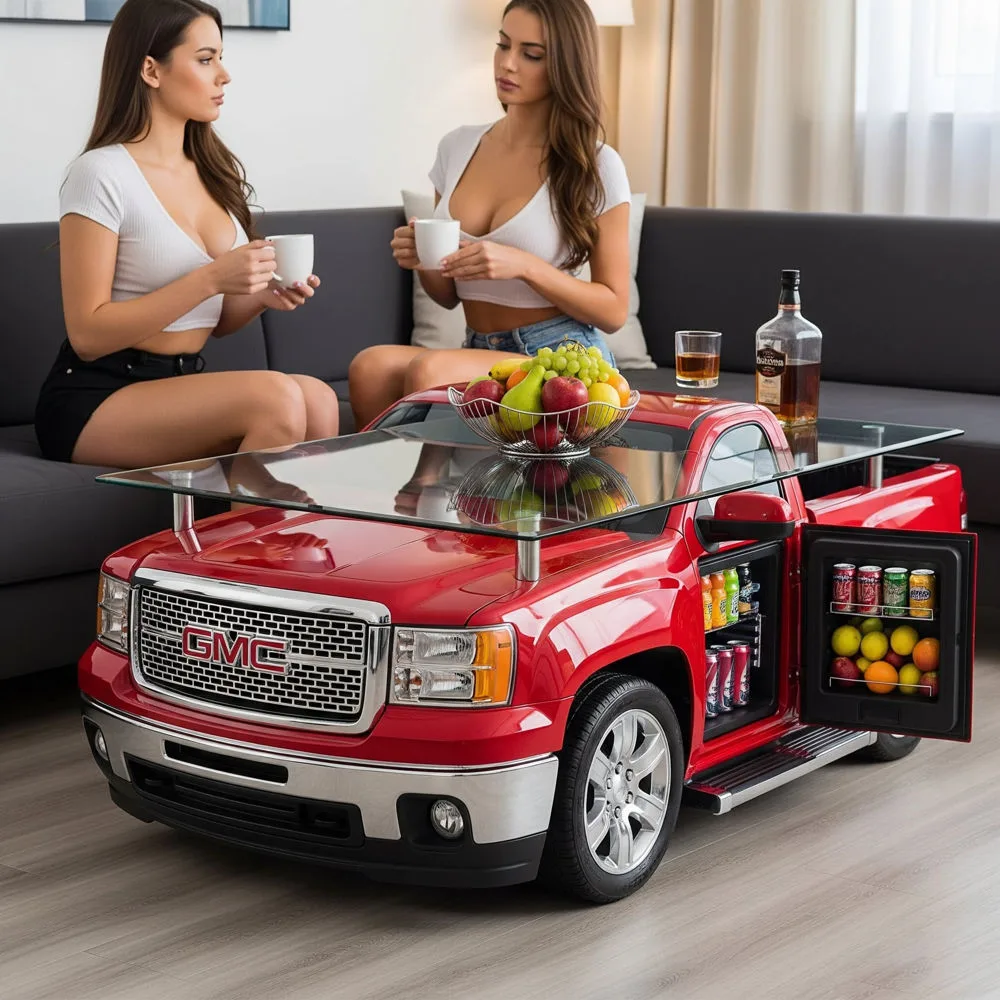The fusion of automotive nostalgia with practical home furnishings has birthed one of the most distinctive conversation pieces in interior design: the pickup truck coffee table. These remarkable furniture items transform vintage truck beds into functional works of art that serve as the centerpiece of living spaces while preserving automotive history. Whether you’re a car enthusiast, appreciate industrial design, or simply want a unique statement piece, a pickup truck coffee table brings character, history, and functionality to any room.
In this comprehensive guide, we’ll explore everything you need to know about these distinctive pieces—from finding the perfect truck bed and restoration techniques to styling tips and placement ideas. We’ll also share inspiring design variations and DIY approaches for those ready to tackle this rewarding project themselves.
The Appeal of Pickup Truck Coffee Tables
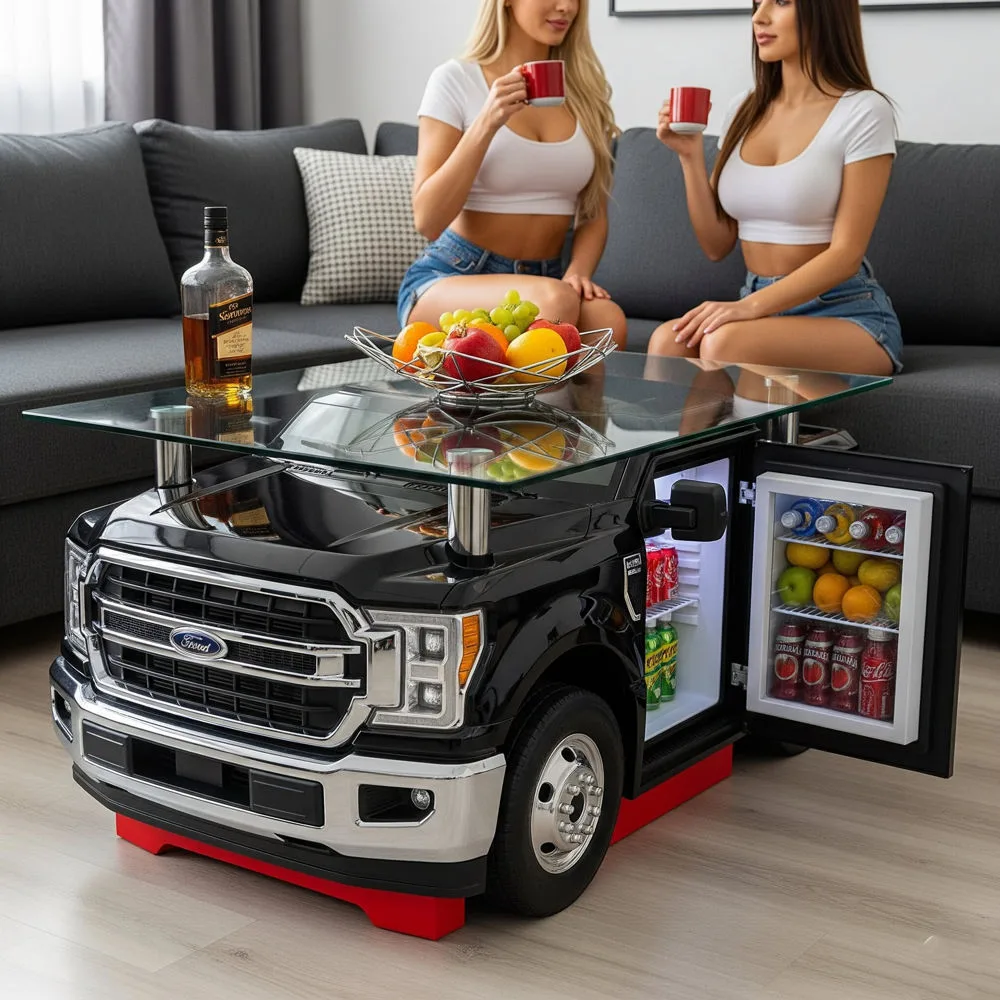
A Blend of History and Function
Pickup truck coffee tables represent more than just furniture; they’re pieces of American automotive history repurposed for modern living. Each table tells a story through its weathered paint, authentic patina, and manufacturer badges. These conversation starters blend industrial charm with practical function, creating furniture that’s both useful and emotionally resonant.
Sustainable Upcycling
In an era of increasing environmental consciousness, repurposing a pickup truck bed exemplifies creative recycling at its finest. Rather than allowing these classic automotive components to rust in junkyards, transforming them into furniture gives them new life and purpose while reducing waste. This sustainable approach to home furnishing appeals to eco-conscious consumers looking for unique, environmentally friendly decor options.
Design Versatility
The beauty of pickup truck coffee tables lies in their versatility. Whether your interior leans toward industrial, rustic, farmhouse, contemporary, or eclectic, these tables can complement various design aesthetics. From weathered patinas that showcase decades of use to sleek, restored finishes that highlight the original manufacturing details, these pieces adapt to diverse style preferences.
Sourcing Your Pickup Truck Bed
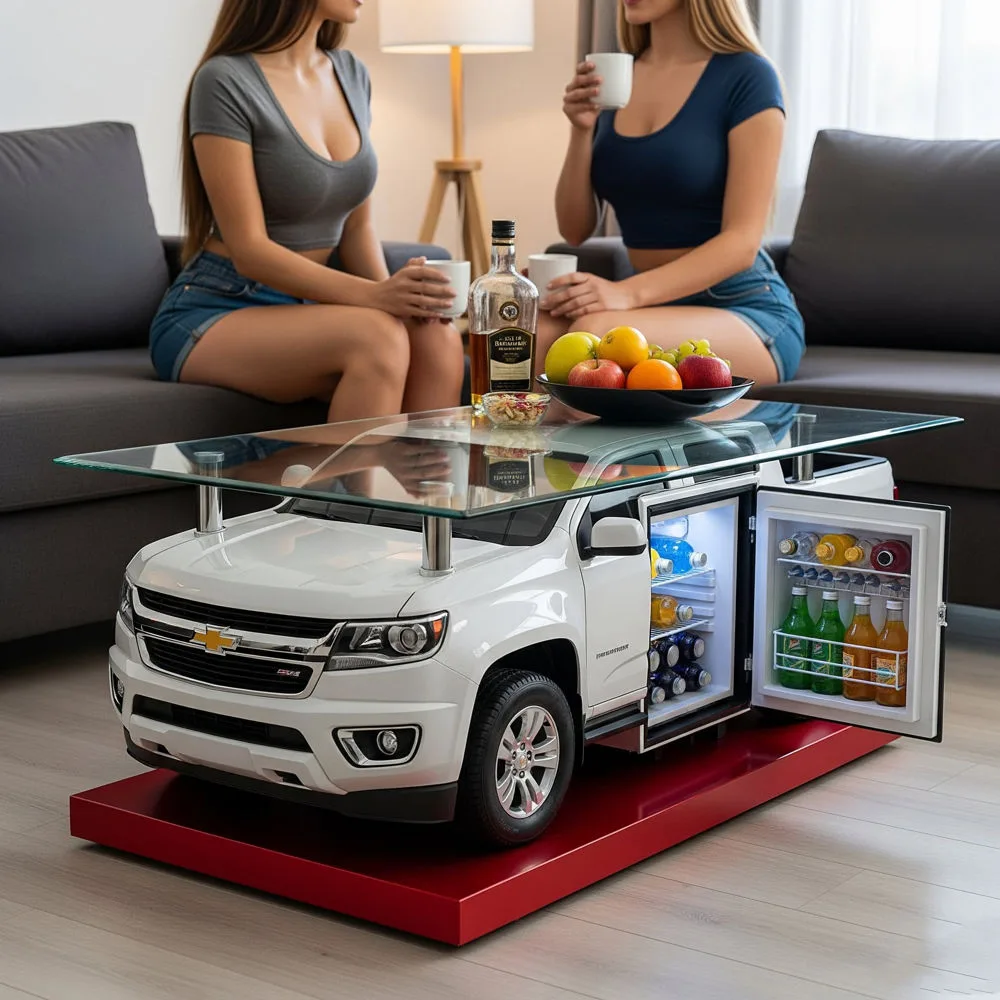
Where to Find Vintage Truck Beds
Finding the perfect truck bed is the first step in creating your statement piece. Here are promising sources to explore:
- Salvage yards and auto recyclers: These businesses often have retired truck beds from various makes, models, and eras.
- Online marketplaces: Websites like eBay, Facebook Marketplace, and Craigslist frequently list vintage truck parts.
- Classic car shows and swap meets: These events attract enthusiasts who might sell parts or know where to find them.
- Rural properties: Farms and ranches sometimes have abandoned trucks that owners might sell for parts.
- Specialty restoration shops: Businesses that restore classic vehicles sometimes sell excess inventory.
What to Look For
When selecting a truck bed for your coffee table project, consider these factors:
- Size and proportions: Ensure the dimensions will work in your space. Smaller beds from compact pickups often work better in average-sized living rooms.
- Condition: While some rust and wear add character, excessive structural damage can complicate your project.
- Brand heritage: Consider choosing a brand with personal significance or one known for iconic designs, such as classic Ford, Chevrolet, or Dodge models.
- Age and style: Truck beds from different eras have distinct aesthetics. Beds from the 1940s-1970s typically feature more curved, artistic designs compared to modern utilitarian styles.
- Original features: Details like tailgates, emblems, and original paint add authenticity and visual interest.
Popular Truck Models for Coffee Tables
Some pickup truck models have proven particularly popular for coffee table conversions due to their distinctive designs and cultural significance:
- 1940s-50s Chevrolet Advance Design series: Known for rounded fenders and classic styling
- 1953-56 Ford F-100: Features beautiful curves and iconic badging
- 1947-54 GMC “Jimmy”: Recognizable front end with bold grille designs
- 1967-72 Chevrolet C10: Clean lines with a timeless appeal
- 1973-79 Ford F-Series: Square body style that defines an era of truck design
The Transformation Process
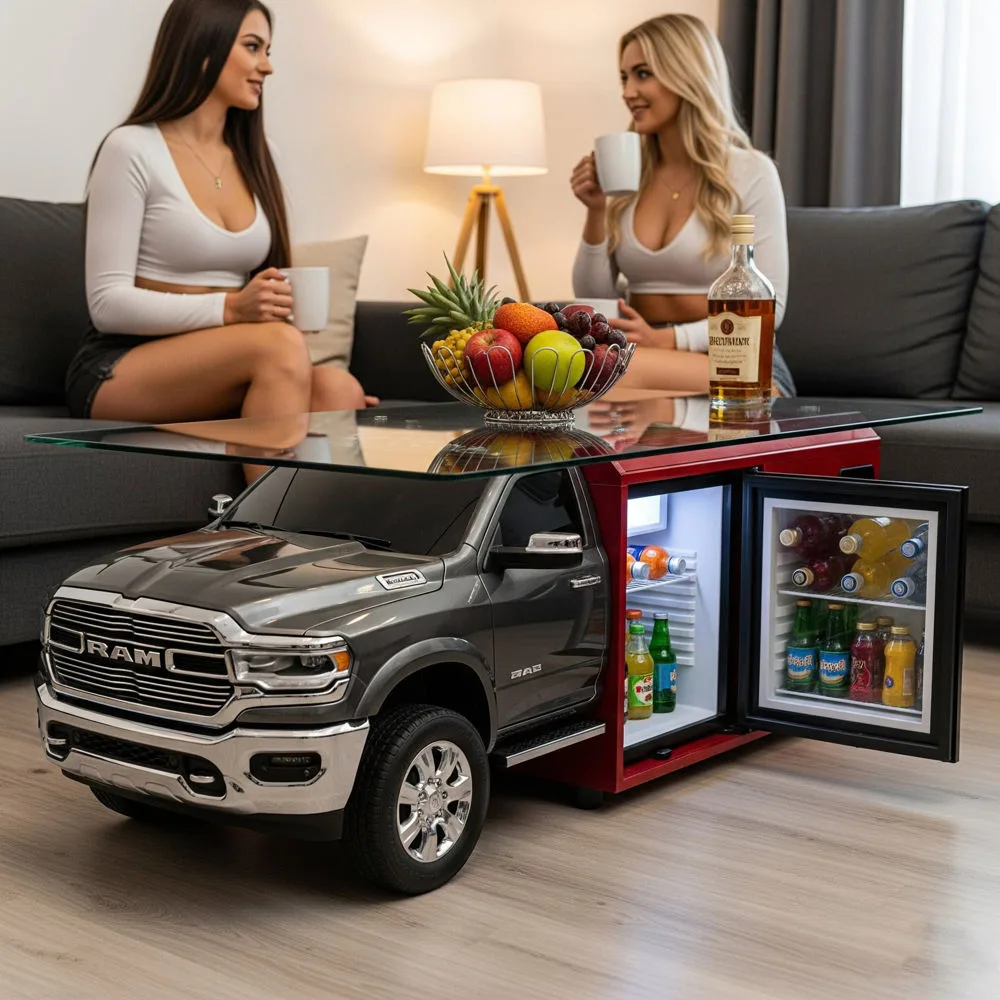
Initial Assessment and Planning
Before cutting or welding, carefully assess your truck bed and develop a clear plan:
- Measure everything: Document the exact dimensions to determine how the piece will fit in your space.
- Decide on height: Standard coffee tables range from 16-18 inches tall, so plan your base accordingly.
- Consider functionality: Decide whether you want storage capacity, a glass top, or other special features.
- Preservation vs. restoration: Determine whether you’ll maintain the patina or restore/repaint the piece.
- Safety assessment: Check for sharp edges, structural weaknesses, or other hazards that need addressing.
Cleaning and Restoration
Transforming a truck bed requires thorough cleaning and strategic restoration:
- Remove debris and loose material: Clear out years of accumulated dirt and loose rust.
- Chemical cleaning: Use appropriate degreasers and metal cleaners to remove oil, grease, and grime.
- Rust treatment: Depending on your aesthetic goals, either treat rust to prevent further corrosion or preserve it for character.
- Structural repairs: Address any compromised areas that might affect the table’s stability.
- Surface preparation: Sand, wire brush, or media blast surfaces according to your finishing plans.
Creating the Base
The base structure is crucial for stability and achieving the right height:
- Steel frame construction: Many builders create welded frames from angle iron or square tubing.
- Wooden bases: For a warmer look, solid hardwood bases can complement the metal truck bed.
- Industrial casters: Adding quality wheels can enhance the automotive theme while providing mobility.
- Height considerations: Design the base to achieve a comfortable coffee table height, typically 16-18 inches.
- Weight distribution: Ensure the base adequately supports the bed’s weight and provides stability.
Surface Treatment and Finishing
The finish determines much of the table’s final character:
- Preserving original paint: Clear coats can protect remaining factory finishes while highlighting authentic wear.
- New paint application: Some prefer to restore beds to original colors or create custom finishes.
- Patina enhancement: Techniques like acid washing can enhance natural aging patterns.
- Rust preservation: Special sealants allow you to keep rust aesthetics without ongoing corrosion.
- Metal treatments: Polishing chrome elements or badges brings contrast to weathered surfaces.
Adding the Tabletop
The tabletop material significantly influences both aesthetics and functionality:
- Glass tops: Clear glass showcases the bed’s interior details while creating a smooth surface.
- Wood inserts: Replace the truck bed floor with finished wood for warmth and practicality.
- Epoxy pours: Clear or tinted epoxy can preserve small items or memorabilia inside the bed.
- Original bed floor: Restored and sealed original bed floors maintain authenticity.
- Combination approaches: Many tables feature partial glass tops that reveal specific features while providing solid surfaces elsewhere.
Design Variations and Styling
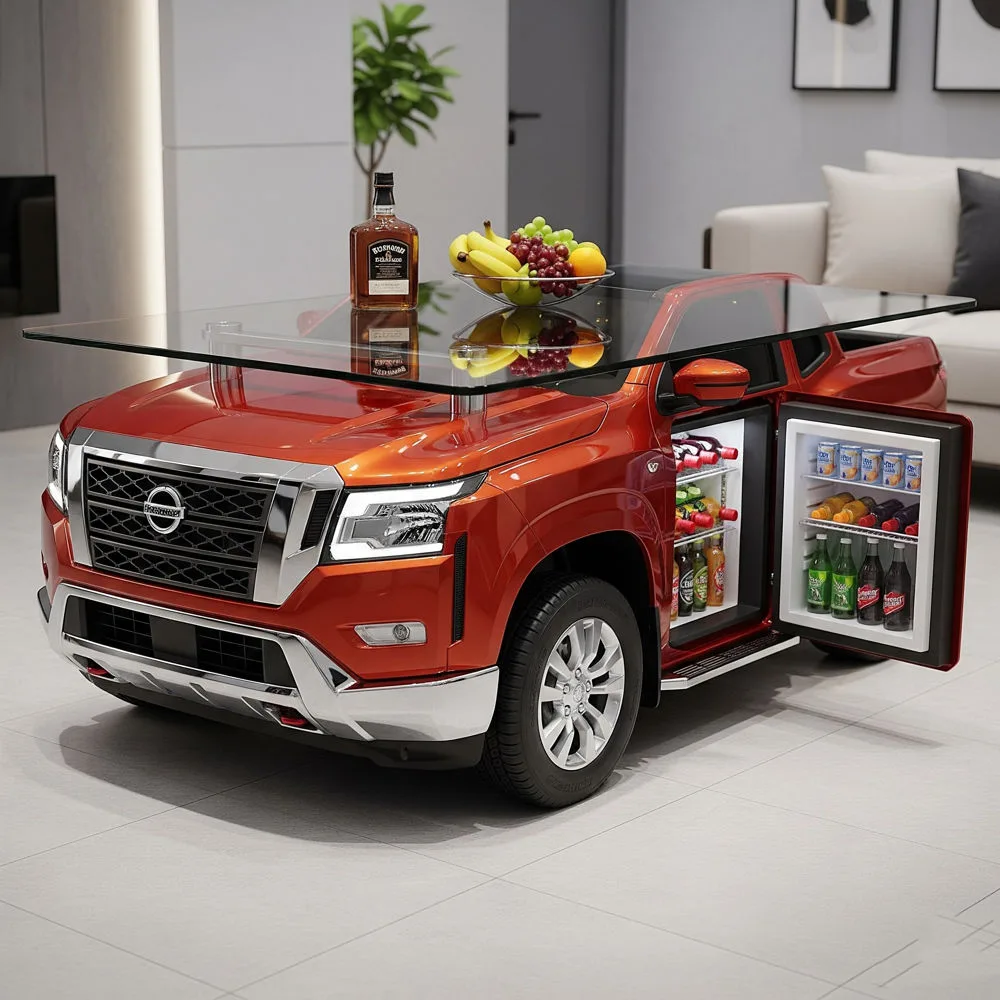
Style Matching
Pickup truck coffee tables can complement various interior design styles:
- Industrial: Emphasize raw metal, visible welds, and mechanical elements
- Rustic/Farmhouse: Highlight weathered patinas and pair with natural wood elements
- Modern: Choose cleaner lines and minimalist bases with glass tops
- Man cave/Garage chic: Incorporate additional automotive elements like license plates or hood ornaments
- Eclectic: Mix the industrial quality of the truck bed with unexpected textiles and accessories
Creative Enhancements
Beyond the basic concept, consider these enhancements to personalize your piece:
- Lighting integration: LED strips installed underneath or inside the bed create dramatic effects
- Storage solutions: Adding hidden compartments or utilizing the natural bed space
- Memorabilia display: Use the bed to showcase related collectibles under glass
- Living elements: Small planters incorporated into sections of the bed
- Functional features: Cup holders, charging stations, or pop-up sections
Practical Considerations
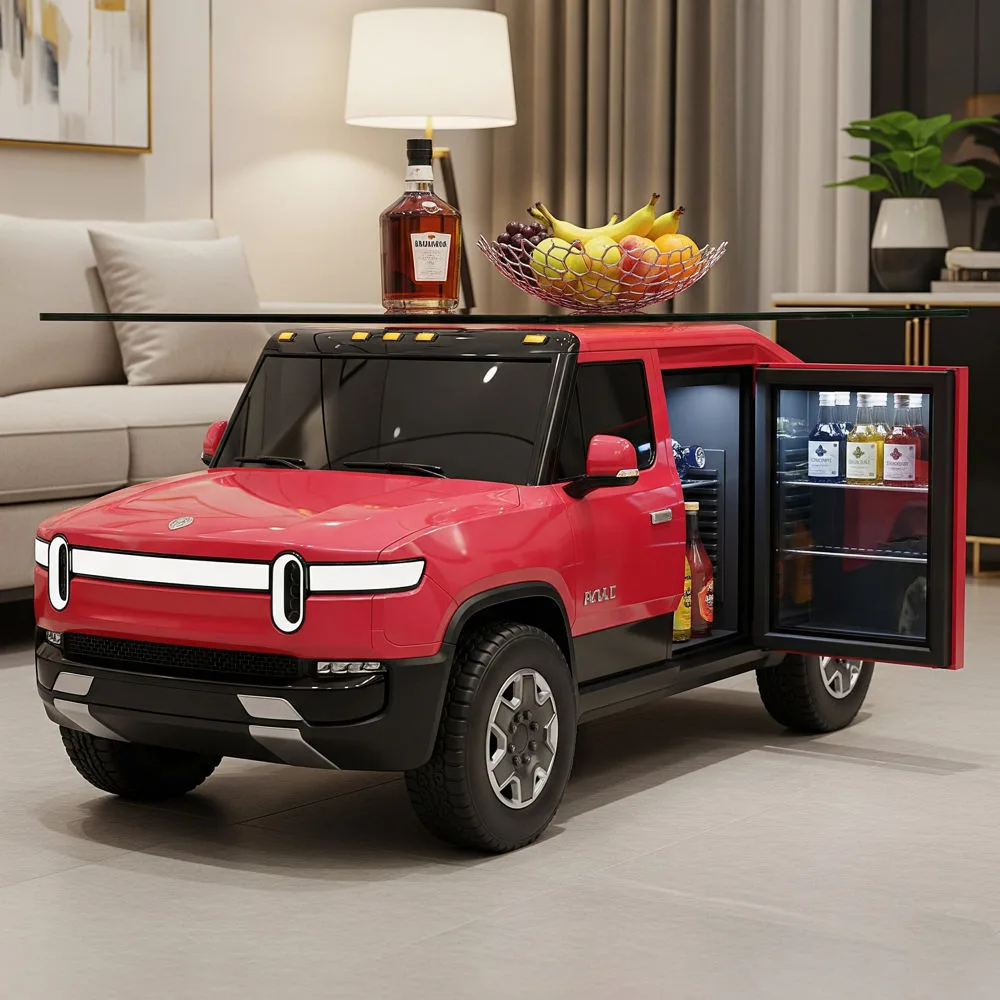
Maintenance Tips
Proper care ensures your pickup truck coffee table remains beautiful for years:
- Regular dusting: Use soft cloths to prevent scratch accumulation
- Metal maintenance: Apply appropriate products to prevent new rust or tarnish
- Glass care: Clean glass surfaces with proper glass cleaners
- Structural checks: Periodically inspect welds and connection points
- Touch-ups: Address any finish damage promptly to prevent deterioration
Weight and Mobility Factors
These tables can be substantial pieces that require planning:
- Floor load considerations: Be aware that truck bed tables can weigh significantly more than conventional furniture
- Mobility solutions: Quality casters or built-in handles can help when rearranging
- Delivery planning: Professional moving assistance may be necessary when purchasing or relocating
- Floor protection: Use appropriate pads to prevent damage to flooring
- Space requirements: Allow adequate clearance around the piece for comfortable movement
DIY vs. Professional Creation
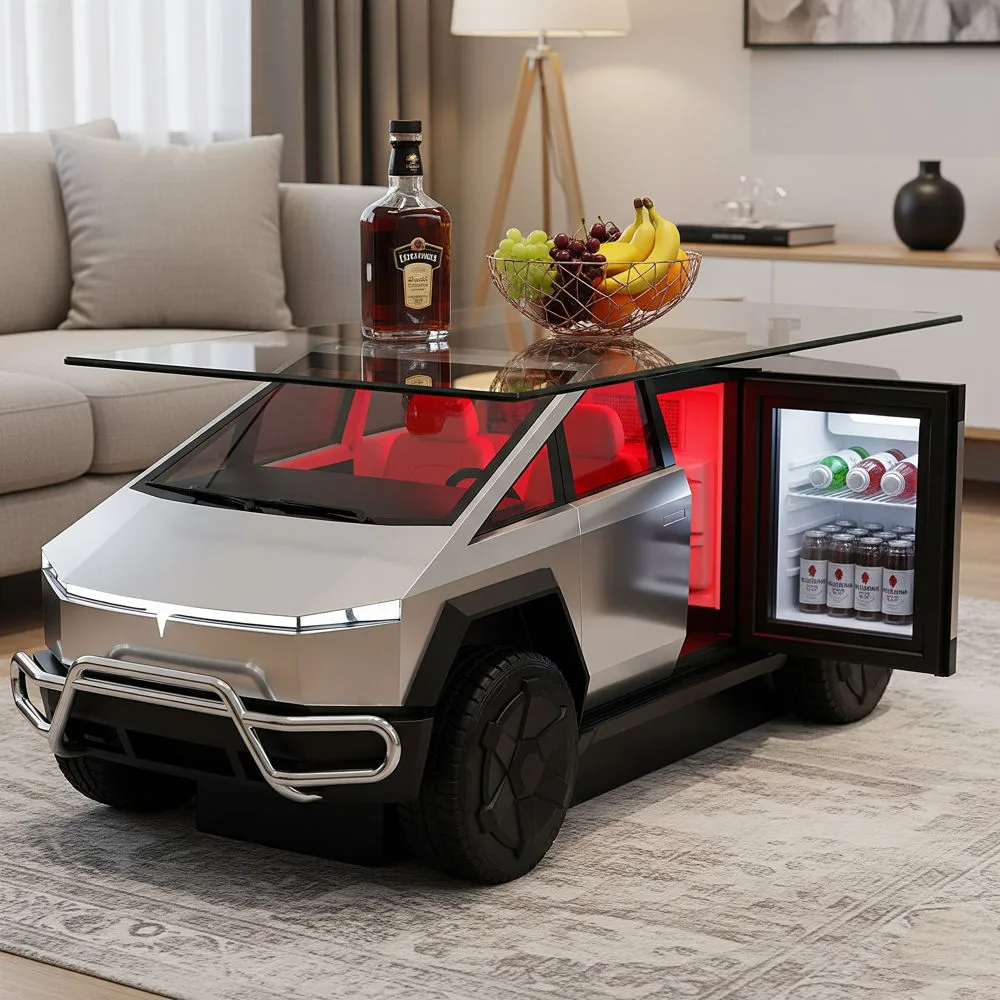
The DIY Approach
For those considering building their own pickup truck coffee table:
- Required skills: Basic metalworking, welding, finishing, and woodworking abilities
- Essential tools: Angle grinders, welders, sanders, painting equipment
- Time investment: Typically 20-40 hours depending on condition and design complexity
- Cost considerations: Usually $500-1,500 in materials plus tool costs
- Learning resources: Online tutorials, automotive restoration forums, and upcycling communities
Professional Options
If DIY isn’t feasible, consider these professional routes:
- Custom furniture makers: Many specialize in automotive-inspired pieces
- Automotive restoration shops: Some offer furniture creation as a sideline
- Ready-made options: Various retailers and artisans sell completed pieces
- Semi-custom collaboration: Work with professionals who can implement your vision
- Cost range: Professionally created pieces typically range from $1,200-5,000+
Styling Your Pickup Truck Coffee Table
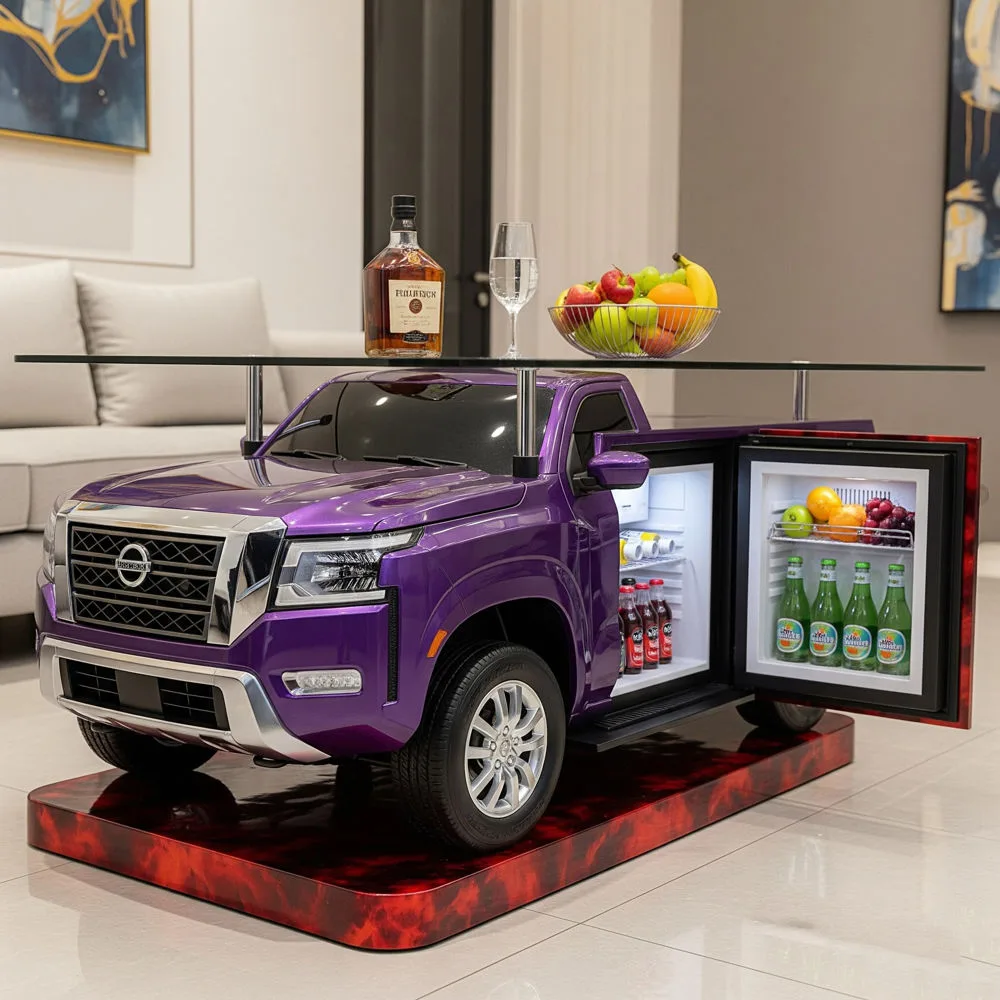
Complementary Furniture
The right accompanying pieces enhance your truck table’s impact:
- Seating choices: Industrial or leather sofas often complement these tables well
- Side tables: Consider coordinating designs or complementary industrial pieces
- Room anchoring: Area rugs can help integrate the table into your space
- Balance elements: Mix in softer textiles to contrast with the metal construction
- Scale considerations: Ensure surrounding furniture has appropriate visual weight
Accessorizing
The right accessories complete the presentation:
- Coffee table books: Automotive, design, or photography volumes
- Natural elements: Plants or wood elements to soften industrial edges
- Complementary materials: Leather trays, metal bowls, or stone coasters
- Negative space: Remember that sometimes less is more—allow the table to shine
- Themed collections: Small displays of related items like miniature cars or vintage gas station memorabilia
Conclusion
A pickup truck coffee table represents more than just a furniture purchase or project—it’s an investment in a conversation piece that blends history, craftsmanship, and functional art. Whether you choose to build one yourself or purchase a professionally crafted piece, these unique tables bring automotive heritage into your living space in a way that’s both practical and visually striking.
The beauty of these repurposed pieces lies in their ability to preserve industrial design that might otherwise be lost to time. Each dent, badge, and weathered section tells a story of American manufacturing and the vehicles that helped build the country. By transforming these elements into central features of your home, you create a bridge between utilitarian history and contemporary living.
As sustainable design continues to gain importance, these upcycled creations demonstrate how creativity can transform overlooked objects into treasured furnishings. Whether you’re drawn to the pickup truck coffee table for its aesthetic appeal, historical significance, or eco-friendly credentials, it represents a thoughtful approach to home design that values heritage, craftsmanship, and individuality.

